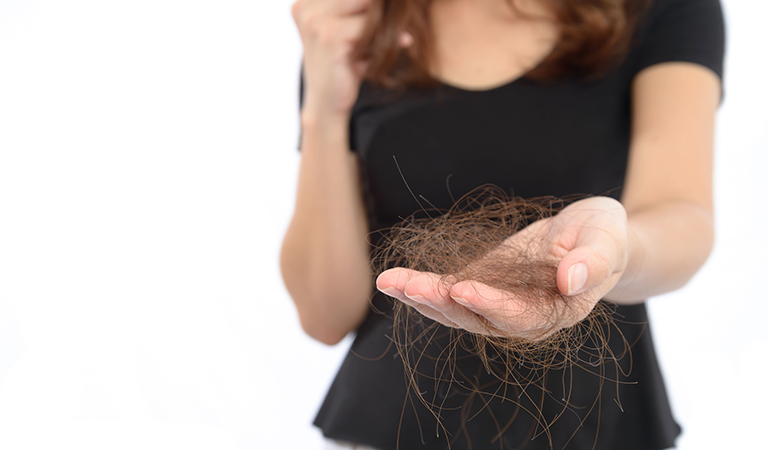Table Of Content

The vitamins and minerals that you consume play a role in the health of your hair follicles and hair growth cycle. However, the exact impact of vitamin intake on hair loss is very complex, and it hasn’t been well-studied. Zinc is an essential trace element, which means that the body cannot generate it on its own; it must be supplied through the diet.
Harvard Health Publishing
Biotin also plays roles in histone modification, cell signaling, and gene regulation [25]. Dietary protein must be broken down into free biotin, which is then stored in the small intestine and liver. An adequate intake of biotin for adults is 30 mcg/day in U.S. populations. The average dietary intake of biotin in Western countries is adequate, and biotin deficiency is rare. Severe biotin deficiency in healthy individuals eating a normal diet has never been reported [26, 27]. While there is no upper limit for biotin intake—as there is no evidence for biotin toxicity—high biotin intake can cause falsely high or falsely low laboratory test results [28].
Biotin

Forest plot of the difference in mean ferritin values between patients and controls. In the first phase, the investigators reviewed the abstracts, and in the second selected full articles and bibliographic lists. If a full paper could not be obtained through the electronic database system, the authors communicated with the authors or requested the full article through ResearchGate.
How do I know which type of hair loss I have?
Deficiency can occur from excessive ingestion of raw egg whites due to binding by avidin. Tocotrienols and tocopherols are members of the vitamin E family and are potent antioxidants. Deficiency results in hemolytic anemias, neurologic findings, and skin dryness. Vitamin E deficiency is rare, but may occur with fat malabsorption disorders. Risk factors for deficiency include living in areas with low selenium soil content (particularly in parts of China, Tibet, and Siberia), long-term hemodialysis, HIV, and malabsorption disorders [48].
vitamin B7 (biotin)
Another possibility is zinc’s role in the Hedgehog signaling pathway [28], a critical component in the pathways that govern hair follicle morphogenesis [29]. You may need higher amounts if you have a condition that interferes with your iron levels. You may also need iron injections if you can't get enough through your diet or with an oral supplement. Iron levels can be corrected by increasing iron in the diet or taking iron supplement pills. If your body can't absorb iron or you have an intestinal problem, however, taking a pill or eating food rich in iron won't correct the problem. If you have iron deficiency anemia, it can lead to a number of symptoms.
Alopecia Hair Loss: What to Know About Jada Pinkett Smith’s Condition - The New York Times
Alopecia Hair Loss: What to Know About Jada Pinkett Smith’s Condition.
Posted: Mon, 28 Mar 2022 07:00:00 GMT [source]
Additionally, arachidonic acid, an omega-6 fatty acid, may promote hair growth by enhancing follicle proliferation [43]. In a review of the literature, no studies regarding niacin levels in patients presenting only with hair loss were identified. A major point when considering supplementation in the absence of known deficiency is that zinc toxicity can occur with excess supplementation.
This will find out if the number of red blood cells you have (your red blood cell count) is normal. To check if you have iron deficiency anaemia, your GP will ask you about your lifestyle and medical history. Selenium is an essential trace element required for the synthesis of more than 35 proteins. Glutathione peroxidase (antioxidant enzyme) depends on selenium as a co-factor. Selenium deficiency occurs in low-birth-weight infants and in patients requiring total parenteral nutrition (TPN).
A better understanding of iron deficiency - With new insights - Radboudumc
A better understanding of iron deficiency - With new insights.
Posted: Wed, 16 Dec 2020 08:00:00 GMT [source]
Acquired biotin deficiency can be due to increased raw egg consumption, where avidin particles attach to biotin and inhibit its absorption into the intestinal gut. The aforementioned medications interfere with biotinidase activity [34]. Evidence suggests that 50% of pregnant women are deficient in biotin [36]. In one study with the aim to determine the effects of isotretinoin on acne vulgaris in the skin, special care was taken to evaluate changes in the hair and hair growth. Consistent with other findings, the authors reported a decrease in hair count, density, and percentage of anagen hairs [19]. As a general rule, consuming too much or over-supplementing vitamin A can cause hair loss [15, 16].

What Is Iron Deficiency Anemia?
The reported rate of iron deficiency in the USA and Canada is 10–12% [36]. The reported prevalence rate for iron deficiency from Asian countries is 20–26% and in different regions of Ethiopia 18–50% [37, 38, 39, 40, 41]. Based on these data, it would appear that ferritin deficiency in women with nonscarring alopecia is not higher than in the general population. Several studies suggested higher cutoff levels of below 30–40 ng/dL as the definition of iron deficiency [5, 29, 42, 43, 44].
Telogen effluvium refers to the excessive shedding of hair follicles, and it occurs when hair follicles prematurely skip to the end of the hair growth cycle, she adds. These treatments that emit red- or near-infrared light are believed to stimulate hair follicles to help hair grow, with a lower risk of side effects compared to topical creams and oral medications. Doctors often prescribe oral medications to be used along with topical minoxidil because studies show the combination boosts hair production.
Thirty-six of 928 identified studies entered the systematic meta-analysis. Nutritional deficiency may impact both hair structure and hair growth. Effects on hair growth include acute telogen effluvium (TE), a well-known effect of sudden weight loss or decreased protein intake [1], as well as the diffuse alopecia seen in niacin deficiency [2]. Studies have also reported potential associations between nutritional deficiency and chronic TE, androgenetic alopecia (AGA), female pattern hair loss (FPHL), and alopecia areata (AA) [3,4].
This is due to less oxygen reaching your tissues, depriving them of energy. Luckily, there are a lot of symptoms of iron deficiency anaemia, meaning there are lots of indicators that can help you to identify this nutritional deficiency. With treatment, you can help reverse both the iron deficiency and the hair loss.
To better understand the link between iron deficiency and excessive hair loss in women, a study examined more than 5,000 women aged 35–60. Among participants experiencing excessive hair loss or shedding, roughly 10% more had low iron stores compared to the remainder of the population (Deloche, 2007). While the science looks promising, further studies are needed to prove a link between iron deficiency and hair loss. To prevent iron deficiency anemia in infants, feed your baby breast milk or iron-fortified formula for the first year. Cow's milk isn't a good source of iron for babies and isn't recommended for infants under 1 year.
In more severe cases of anemia, iron supplements may be needed for hair regrowth and to prevent future hair loss. A visit to the doctor usually involves discussing your medication history and symptoms. Following a physical exam, your provider can run a blood test to see how much iron is stored in your body. Your provider will also likely test your hemoglobin and hematocrit levels. These and iron tests are regarded as the most efficient and cost-effective way to diagnose an iron deficiency (DeLoughery, 2017).

No comments:
Post a Comment